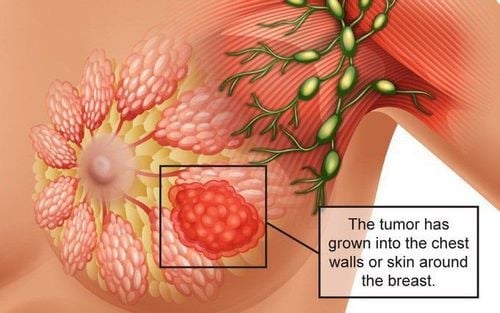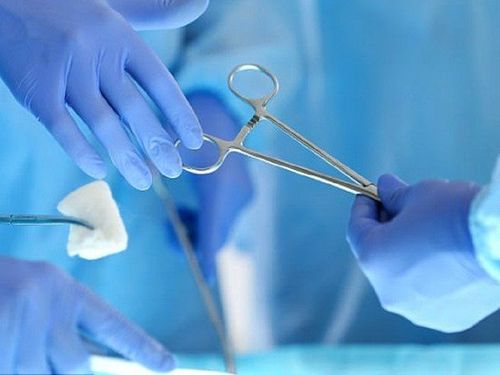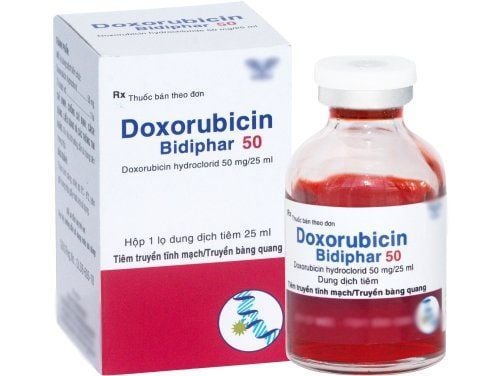This is an automatically translated article.
The article was professionally consulted with Specialist Doctor II Tran Thi Mai Huong - Obstetrician and Gynecologist - Department of Obstetrics and Gynecology - Vinmec Hai Phong International General Hospital.Lymphoma of the breast is a rare type of breast tumor that can be benign, malignant, or borderline between benign and malignant. Local recurrence is a common complication of syphilis, whether benign or malignant.
1. What is breast chlorophyll?
Phyllodes tumor is a rare type of breast tumor. Their cell pattern resembles leaves and the name "phyllodes" comes from the Greek word for "leaf-like".Breast syphilis is a well-defined tumor, consisting of connective tissue and epithelial components, similar to fibroadenomas, but with more connective tissue components. Breast chlorophyll tumors usually progress slowly, most of them are benign, although they are often large in size, rarely seen, accounting for 0.5-1% of all tumors in the mammary gland.
2. How are breast chlorophyll tumors formed?
Unlike breast cancer, chlorophyll tumors start outside the milk ducts and lobes and grow in the connective tissue of the breast. The stroma consists of fatty tissue and ligaments that surround the ducts, lobes, blood, and lymphatic vessels in the breast.Although most breast chlorophyll tumors are benign (not cancerous), some are malignant (cancerous) and some are borderline (between noncancerous and cancerous). Doctors often recommend surgery to reduce the risk of chlorophyll tumors coming back in the breast (local recurrence).
Breast chlorophyll tumors can occur at any age, mostly occurring in women aged 42-45 years. Benign chlorophyll tumors are usually diagnosed at a younger age than malignant chlorophyll tumours. Breast phyllodes tumors are extremely rare in men.

3. Symptoms of breast phyllodes tumor
The most common sign of a breast chlorophyll tumor is a very palpable breast lump. These tumors usually form in the upper quadrant of the breast. Breast phyllodes tumors tend to grow rapidly. In a few weeks or months, a tumor can reach as little as 2-3 cm. The average size is about 4cm, but they can be many times larger. About 20% of phyllodes tumors exceed 10 cm in diameter. This type of tumor is usually painless. The patient may be palpable when the skin of the breast is pressed, and the tumor may extend into the veins under the skin, causing that area of the breast to appear blue. Cystic tumors can cause ulcers to form on the skin of the breast, but this is very rare. Ulcers can form whether the tumor is benign or malignant. Phyllodes can form in both breasts, but this is rare.4. Diagnosis of breast phyllodes tumor?
Phyllodes tumors are rare - they make up 0.3% to 0.5% of breast tumors in women. As a result, doctors are less likely to encounter them, which can make diagnosis more difficult. Also, a phyllodes tumor may look like a type of solid breast growth called a fibroadenoma. A fibroid is a benign tumor that grows out of normal breast cells. Fibroids are the most common type of breast mass, and they often develop in young women. There are two main differences between tumor types.First, breast phyllodes tumors tend to grow faster than fibroids. Second, phyllodes tumors tend to develop about 10 years later, when people are in their 40s. Fibroids tend to appear when people are in their 20s and 30s. These differences may help accurate diagnosis by the doctor.
As with other tumors, a diagnosis of a phyllodes tumor may include the following tests:
Mammogram : Results will show a round mass with well-defined edges. In some cases, round lobes may appear in the tumor. MRI or ultrasound: These imaging tests can provide more detail. Biopsy takes a sample of the tumor for examination under a microscope: This is the only way to tell if this growth is a chlorophyll tumor. There are two types of biopsies: Core needle biopsies, which use a special hollow needle to take a sample of the tumor through the skin, and excisional biopsies, where the entire tumor is removed. In addition to confirming the tumor type, a biopsy can help determine if the tumor is benign, malignant, or the boundary between benign and malignant.
5. Treatment of breast phyllodes tumor

If a cancerous phyllodes tumor recurs, your doctor may recommend a mastectomy, surgery to remove part or all of the breast. They may also recommend radiation therapy, chemotherapy, or both. Although benign phyllodes tumors may not have spread beyond the breast, they need to be treated to prevent them from growing larger. Otherwise, the tumor may be visible and break through the layers of the skin, causing pain and discomfort to the patient.
After removing a breast phyllodes tumor, you may feel pain at the surgical site, but further complications are rare. Benign syphilis breast tumors are less likely to recur than malignant syphilis tumours. Your doctor will monitor for recurrence, usually within 1-2 years after removal.
However, if left untreated, even benign chlorophyll tumors can cause complications. Therefore, anyone who notices any breast-related changes should see a hospital with a breast specialist as soon as possible.
To help customers detect and treat breast - gynecological cancer early, Vinmec International Hospital has a package of screening and early detection of breast - gynecological cancer, helping customers detect diseases early. and easy treatment, even when there are no symptoms.
Please dial HOTLINE for more information or register for an appointment HERE. Download MyVinmec app to make appointments faster and to manage your bookings easily.














